Emacs Utilities
Table of Contents
1 Emacs Utilities
1.1 Overview
Some Emacs utilities and goodness.
| Feature | Entry Point | Description |
|---|---|---|
| Help Commands | ||
| Help for all help commads | M-x help-for-help | |
| Emacs built-in tutorial | M-x help-with-tutorial | Open Emacs tutorial. |
| Emacs built-in localized tutorial | M-x help-with-tutorial-spec-language | Emacs built-in tutorial in many languages like Russian, Portuguese … |
| Package Manager | ||
| Package Manager | M-x list-packages | List all packages available. |
| M-x package-install | Install some package | |
| Info page and Man page - Unix docs | ||
| Info page | M-x info / M-x heml-info | Info page reader. The helm-version is provided by heml package. |
| Manpage | M-x woman / M-x helm-man-woman | Manpage Reader |
| File Manager and edit remote files | ||
| File manager | M-x dired or C-x d | File manager and directory editor |
| Tramp mode | Tramp mode - edit remote files, edit as super user and open | |
| remote directories through ssh, sftp, telnet and ftp | ||
| Programming | ||
| Compile mode | M-x compile | Run any compilation command, compiler or build automation tool like make or ant. |
| GNU Debugger Interface | M-x gdb | |
| Git Version Control System | M-x magit-status | Git user interface provided by the magit package. |
| Diff files | M-x ediff | File diff viwer |
| Diff buffers | M-x ediff-buffers | Buffers diff viewer like ediff |
| VIM Emulation | M-x evil-mode | Emulates VI/VIM editor behavior. It is provided by the evil package. |
| Shells | ||
| Shell Command | M-x shell-command | Run a batch shell command like ifconfig or dmesg (Linux) |
| Async shell command | M-x async-shell-command | Run any shell command asynchronously. |
| Eshel | M-x eshell | Multi platform shell written in Elisp and highly integrated to Emacs. |
| Ielm | M-x ielm | Elisp Interactive shell to control and Debug Emacs |
| System Related Commands | ||
| Copy file | M-x copy-file | Copy a file. Prompt user for a file to copy. |
| Delete file | M-x delete-file | Prompt user for a file to delete. |
| Make directory | M-x make-directory | Creates a new directory. Equivalent to shell command $ mkdir |
| Delete directory | M-x delete-directory | Delete a directory. Promps the user for a directory to delete. |
| Copy directory | M-x copy-directory | Copy directory. |
| Task manager/ Process manager | M-x proced | Htop like multi platform task manager. |
| Network Tools | ||
| Network information | M-x ifconfig | Show iformation about network interfaces |
| Ping | M-x ping | Ping a host name or ip address |
| Traceroute | M-x traceroute | Traceroute a host name or ip address |
| ARP | M-x arp | Display the command arp output. |
| Routing Table | M-x route | Show routing table. |
| Whois | M-x whois | Run whois command to show information about route. |
| Telnet | M-x telnet | Telnet login. It is the acient version of SSH. |
| Misc | ||
| Calculator | M-x calc | RPN (Reverse Polish Notation) calculator like HP-48g engineering calculator. |
| Color Pallete | M-x list-colors-display | Display a collor pallete. |
Note:
- M-x ifconfig - runs ipconfig on Windows and ifconfig or ip on Linux. It is platform agnostic.
- To Emacs' tutorial (help-with-tutorial) work the cua-mode must be disabled (M-x cua-mode to disable it).
Fun
| Command | Description |
|---|---|
| M-x doctor | If you fell bad, your country is in a endless recession … |
| M-x life | Run Conway's Life simulation. |
| M-x dunnet | Text based adventure game |
| M-x tetris | Play Tetris. |
| M-x hanoi | Towers of Hanoi. |
| M-x zone | Make buffers go crazy!! |
| M-x zone-leave-me-alone | Stop zoning out. |
1.2 Shells
Emacs have built-in commands to run shells.
| Name | Command: M-x <command> | Description |
|---|---|---|
| shell | M-x shell | Runs an inferior shell app. It can run bash, zsh and etc. |
| term | M-x term | Emacs' terminal emulator that can run apps like top, vim, bash and etc. |
| It alows command line line completion inside Emacs in apps like bash, zsh and python . | ||
| eshell | M-x eshell | Emacs' built-in shell written in Elisp. it has elisp implementation of cd, ls, pwd |
| and other standard Unix commands and apps. Works on all operating systems. Eshell | ||
| also can run Elisp functions. It is a good alternative to Microsoft Windows | ||
| terminal emulator cmd.exe. | ||
| ielm | M-x ielm | Emacs' elisp shell that can be used to control, test and interact with Emacs. |
Emacs also have commands to run programming languages shells:
| Language | Command | Package |
|---|---|---|
| Python | M-x run-python | - |
| Octave | M-x run-octave | - |
| Ruby | M-x run-ruby | inf-ruby |
| Elisp (Emacs Lisp) | M-x ielm | - |
| Scheme | M-x run-scheme | - |
| Lisp | M-x run-lisp | - |
1.3 Async Shell Command
It can run any repls or interactive shell applications, except ncurses-based apps like htop.
Example: M-x async-shell-command "java -jar clojure.jar".
It is useful to run programming languages shells even if there is no
mode or package installed for it. It is possible to rename the shell
buffer with M-x rename-buffer in order to make easier to identify
the buffer.
Examples:
Run sqlite3:
M-x async-shell-command sqlite3
Run scala repl:
M-x async-shell-command scalaand then M-xrename-buffer*scala*
to change the default buffer name to a more readable name *scala*.
Run mono's csharp repl:
M-x async-shell-command csharp
Run Windows powershell:
M-x async-shell-command powershell -Command -
Run Java bean shell (Java Interpreter):
- M-x async-shell-command "java -cp ~/opt/bsh-2.0b4.jar bsh.Interpreter"
or programatically:
(async-shell-command "java -cp ~/opt/bsh-2.0b4.jar bsh.Interpreter")
Defining a command:
(defun run-bsh () "Run Java bean shell." (interactive) (async-shell-command "java -cp ~/opt/bsh-2.0b4.jar bsh.Interpreter"))
Example: Running Haskell REPL.
M-x async-shell-command stack ghci

Example: Install a Haskell package
M-x async-shell-command stack instal turtle

Example: Running Fsharp REPL
M-x async-shell-command fsi
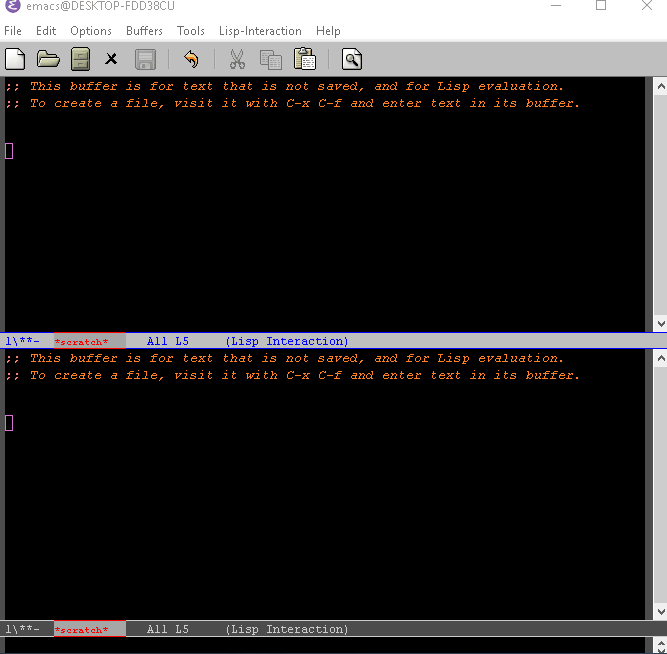
Example: Ping a server to test connection 8.8.8.8 (Google's DNS)
M-x async-shell-command ping 8.8.8.8

1.4 Compiling in Emacs - M-x compile
1.4.1 Compilation Commands
To compile any code use:
- To compile:
M-x compile <compilation command> - To recompile:
M-x recompileor type g at the compilation buffer.
Compilation Commands
| Command | Key binding | Description |
|---|---|---|
| M-x compile | Run a compilation command | |
| M-x recompile | g (compilation buffer) | Run a compilation command again. |
| M-x kill-compilation | C-c C-k (compilation bufffer) | Stop compilation process. |
| M-x compilation-next-error | M-n | Go to next error |
| M-x compilation-previous-error | M-p | Go to previous error |
Compilation Buffer Key bindings
| Command | Key binding | Description |
|---|---|---|
| M-x recompile | g | Compile again running same compilation command. |
| M-x quit-window | q | Quit compilation buffer |
| M-x kill-compilation | C-c C-k | Stop compilation process |
| < | Go to beginning of compilation buffer. | |
| > | Go to end of compilation buffer. | |
| M-x describe-mode | h | |
| RET | Typing Return at compilation error goes to error location. | |
| M-x rename-buffer | To use multiple compilation buffers, rename it with this command. | |
- Note: The command
M-x compileprovides completion for Makefile targets by typingM-x compile make <tab>.
1.4.2 Setting compilation key bindings
The code block bellow will set the key bindings as shown in the following tables:
Key bindings for outside compilation buffer.
| Key binding | Description |
|---|---|
| f9 | Run M-x compile |
| Windows-Key/Super-f9 | Run M-x |
| M-[ | Go to next compilation error |
| M-] | Go to previous compilation erro |
Key bindings for compilation buffer
| Key binding | Description |
|---|---|
| q | Quit compilation buffer (default) |
| g | Run M-x recompile (default) |
| c | Run a new compilation command |
| k | Kill compilation |
| mm | Run make - M-x compile 'make' |
| mc | Run make clean - M-x compile 'make clean' |
| mp | Run make clean and make again. |
(global-set-key [f9] #'compile) ;; Not s-f9 means Windows Key/f9 (global-set-key [s-f9] #'recompile) (global-set-key (kbd "M-[") #'compilation-previous-error) (global-set-key (kbd "M-]") #'compilation-next-error) (define-key compilation-mode-map "c" #'compile) (define-key compilation-mode-map "k" #'kill-compilation) (define-key compilation-mode-map "mm" (lambda () (interactive) (compile "make"))) (define-key compilation-mode-map "mc" (lambda () (interactive) (compile "make clean"))) (define-key compilation-mode-map "mp" (lambda () (interactive) (compile "make clean && make")))
1.4.3 Creating custom compilation commands
- Compile Haskell
Compile single-file haskell apps with stack:
(defun compile-haskell () "Compile a haskell .hs file." (interactive) (save-buffer) (compile (format "stack exec -- ghc %s -o %s.bin" (buffer-file-name) (file-name-base (buffer-file-name)) ))) (defun compile-haskell-run () "Compile a haskell .hs file and runs the executable." (interactive) (save-buffer) (compile (format "stack exec -- ghc %s -o %s.bin && ./%s.bin" (buffer-file-name) (file-name-base (buffer-file-name)) (file-name-base (buffer-file-name)) )))
The command M-x compile-haskell can be used to compile this code bellow that will produce the executable myApp.bin.
The command
M-x compile-haskell-runcompiles the code and runs the app.File: codes/myApp.hs
import qualified System.Directory as D main :: IO () main = do putStrLn "Hello World Haskell!" D.getDirectoryContents "/" >>= mapM_ putStrLn
- Compile F# (Fsharp)
The command
M-x compile-fsharp-runcompiles a F# app .fsx to .exe and runs it with mono.(defun compile-fsharp-run () "Compile a Fhsarp .fsx file to .exe .NET executable." (interactive) (save-buffer) (compile (format "fsc --target:winexe --platform:anycpu --standalone %s --out:%s.exe && mono %s.exe" (buffer-file-name) (file-name-base (buffer-file-name)) (file-name-base (buffer-file-name)) )))
This command can be used to compile the file helloWinform.fsx to helloWinform.exe and run it.
File: codes/helloWinform.fsx
open System.Windows.Forms open System.Drawing let f = new Form () f.Text <- "Hello world" f.Name <- "Form1" f.BackColor <- Color.Blue let btn = new Button (Text= "Click Me", BackColor = Color.Green) f.Controls.Add(btn) btn.Click.Subscribe(fun _ -> printfn "Click me again") Application.Run(f)
1.4.4 Example
Example: Running a F# script. To see the image fullscreen open: http://imgur.com/a/7Hvrz and click at the image.
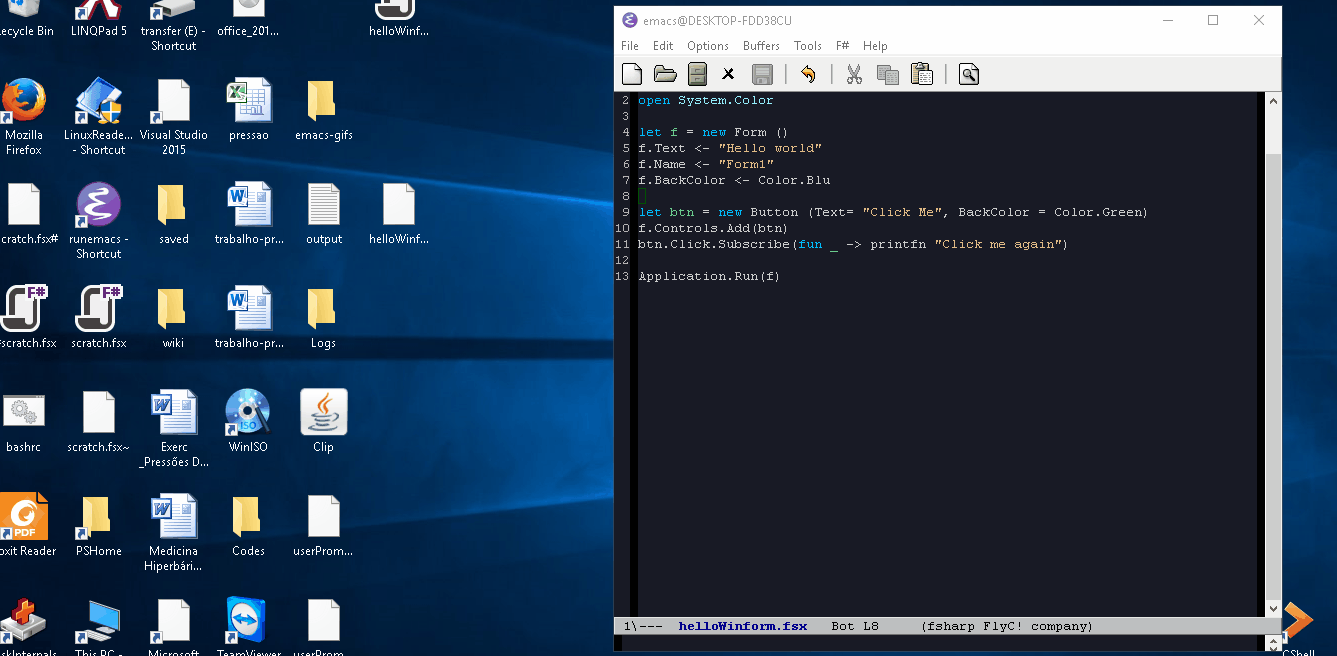
In this case was used the command M-x compile fsi helloWinform.fsx. That runs a F# script performing and all syntax errors and value errors will be shown at the compilation buffer.
Note: This code also works in Linux or OSX. It was recorded in Windows because there was no good GIF recording apps available for Linux at the time this was recorded.
Code used in this example: File - helloWinform.fsx
open System.Windows.Forms open System.Drawing let f = new Form () f.Text <- "Hello world" f.Name <- "Form1" f.BackColor <- Color.Blue let btn = new Button (Text= "Click Me", BackColor = Color.Green) f.Controls.Add(btn) btn.Click.Subscribe(fun _ -> printfn "Click me again") Application.Run(f)
1.5 Emacs in Terminal
Running Emacs in terminal:
emacs -nw
Running Emacs fast without read ~/emacs.d/init.el or ~/.emacs startup file:
emacs -nw -Q- Start Emacs in terminal running Eshell:
Running Emacs in terminal or executing some Elisp command or app:
$ emacs -nw -q --eval '(eshell)'
- Start Emacs in terminal running python:
$ emacs -nw -q --eval '(progn (run-python "python3") (switch-to-buffer "*Python*"))'
See also:
- Eshell Manual: Eshell: The Emacs Shell
- Running Shell Commands from Emacs
1.6 Manpage Reader
To read manpages enter M-x woman.
Example: Rsync manpage.
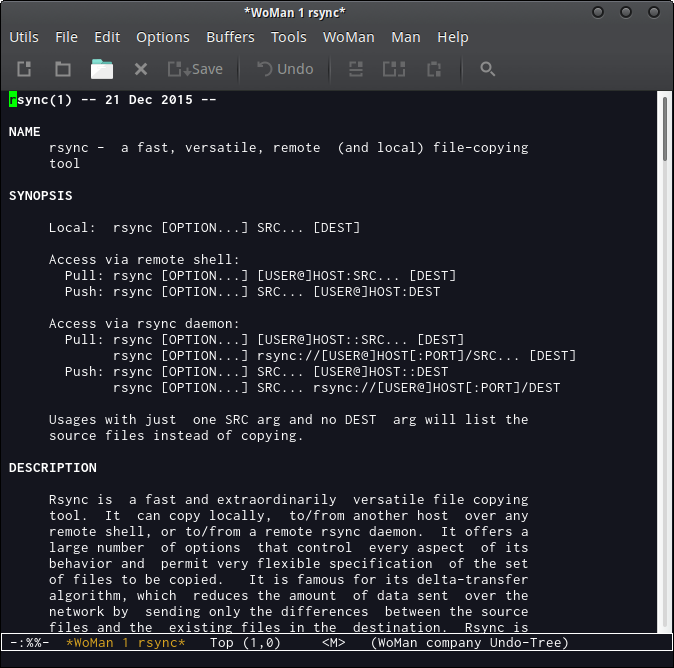
1.7 Info Page Reader
- To Browser info pages and also the Emacs documentation.
M-x info - Search Info pages.
M-x info-apropos
Example: Top info page.
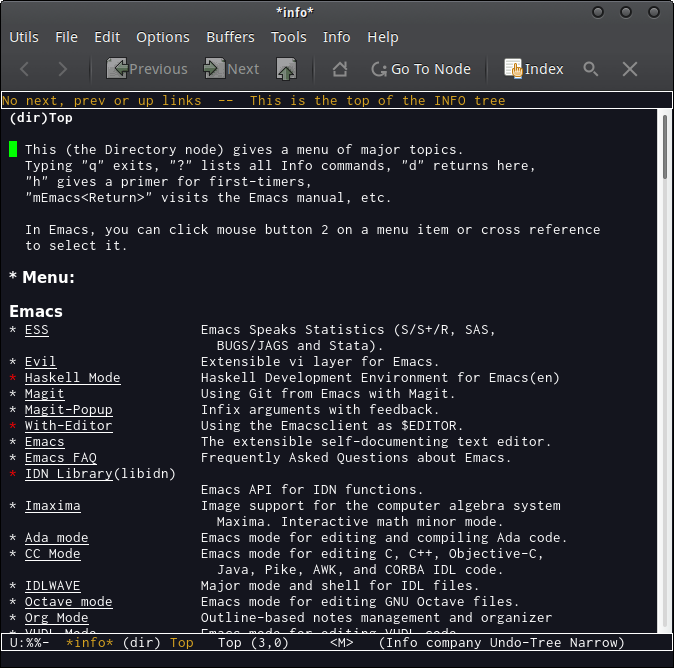
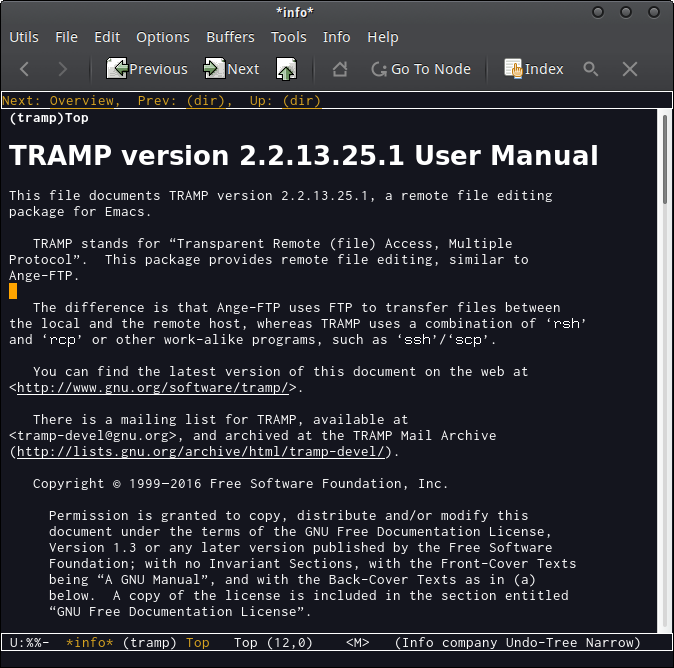
1.8 Calculator - M-x calc
Overview:
- RPN Calculation (Like HP48g series)
- Good for small calculation and verify expected values.
- Scientific calculator
- Bitwise operation: Useful for low level programming like: C-programming, embedded systems, network and machine instructions
- Units - Convert units like meters, inches, feets, min, seconds, bits, bytes …
- Functions (cos, sin, exp bound to keybindings)
- Date calculations
- Symbolic Math
Documentation
| Describe keybindings | C-h m |
| Calc Info manual | M-x calc-info |
Stack Commands
| Dup | RET | Duplicate last number of stack. |
| Swap | Tab | Swap the last two numbers of stack. |
Scientific Functions
| Function | Key |
|---|---|
| set precision | p |
| change sign | n |
| reciprocal 1/n | & |
| square root | Q |
| ln | L |
| exp (ex) | E |
| 10x | H E |
| sin | S |
| cos | C |
| tan | T |
| radian mode | m r |
| degree mode | m d |
| pi π (3.415…) | P |
| factorial | !, k d |
| Prime factorization | k f |
| GCD | k g |
| LCM | k l |
| Error function - erf | f e |
| Error fuinction - erfc | I f e |
Financial Functions
| Enter percentage | M-% |
| Convert to percentage | c % |
| Percentage change | b % |
| present value | b P |
| future value | b F |
| rate of return | b T |
| number of payments | b # |
| size of payments | b M |
| net present value, int rate of return | b N, b I |
Formula transformation
| Description | Key binding | Output |
|---|---|---|
| Enter a formula | ' (-b + sqrt(b2 - 4*a*c) / (2 * a)) | |
| Print the formula in Latex mode | dL | \frac{\sqrt{b^2 - 4 a c} - b}{2 a} |
| Creates a C-lanaguage code | dC | (sqrt(pow(b, 2) - 4*(a*c)) - b) / (2*a) |
| Normal Language | dN | _' (-b + sqrt(b^2 - 4*a*c) / (2 * a))_ |
| Show formula in big display mode | dB |
Unit Conversions
| Description | M-x command |
|---|---|
| Enter number with unites | ' 100 ft/hr |
| Convert to new unit, base unit | u c, u b |
| Convert temperature units | u t |
| Simplify unit expression | u s |
| View unit table | u v |
Numbers with different base
| Description | Emacs Calc | Base 10 |
|---|---|---|
| Binary | 2#11110101 | 245 |
| Octal | 8#27 | 23 |
| Hexadecimal | 16#FFFF | 65535 |
Bitwise Operations
| Keybinding | M-x command | Description |
|---|---|---|
| Number Representation | ||
| d 0 | Decimal (Standard ) | |
| d 2 | Number representation to binary 2#00100111 | |
| 0 d 2 | Two-complement binary | |
| d 6 | Hexadecimal | |
| Word Size | ||
| b w | Set word size (8 bits, 16 bits, 32 bits …) | |
| b c | calc-clip | Clip the current number to current word size. |
| Bitwise operation | ||
| b a | calc-and | Bitwise AND |
| b o | calc-or | Bitwise OR |
| b x | calc-xor | Bitwise XOR |
| b n | calc-not | Bitwise NOT |
| b d | calc-diff | Bitwise difference |
| b r | calc-rshift-binary | Bitwise right shift by 1 bit |
| b l | calc-lshift-binary | Bitwise left shift by 1 bit |
See also
1.9 Magit - Emacs Interface to GIT
See:
Magit Remote Branches
Magit Reference Card:
Another Reference Card
| Command M-x | Key bind | GIT | |
|---|---|---|---|
| magit-status | |||
| magit-status | git status | Magit status is the main entry point to Magit | |
| magit-init | git init | Init a git repository | |
| magit-log | git log | ||
| magit-process-bufffer | $ | Displays the git command and its output | |
| g | Update magit status buffer | ||
| l | History | ||
| L | Verbose history | ||
| !! | git <command> | Run a git command | |
| !s | Magit shell command | ||
Remote Branches
| Command M-x | |
|---|---|
| magit-add-remote | Add a remote branch to magit |
| magit-remote-add | M-a add remote repository |
| magit-remote-remove | M-d remove remote repository |
Untracked files commands:
| s | Add untracked file to staging area | |
| C-u S | Stage all untracked and tracked files | |
| i | Add filename to .gitignore | |
| k | Delete untracked file, forever |
Staging and Commiting
| u | Unstage |
| C-u s | Prompt file for stagin |
| U | Unstage everything that has been staged |
| c | Pop buffer for commit message |
| C-c C-c | Amend commit message |
| C-c C-k | Erage magit-log-edit buffer and bury it |
Tagging
| t t | Create a lightweight tag |
| t a | Create annotated tag |
Stashing
| z z | Create new stash |
| a | Apply stash |
| A | Pop a stash |
| k | Drop a stash |
Branch
| b v | Branch manager |
| b b | Switch to a different branch |
| b n | Create a new branch |
| k | Delete current branch |
| C-u k | Delte branch event if it hasn't been merged |
| m m | Merge the branch in current line to specified |
| g | Refresh branch list |
| q | Buries the branch list and deletes the window |
1.10 Helm utilities
| Command | Description |
|---|---|
| Elisp Programming | |
| M-x helm-M-x | Show all M-x commands |
| M-x helm-apropos | Apropos with helm interface. |
| Search Documentation | |
| M-x helm-info | Search Info pages. |
| M-x helm-man-woman | Search man pages. |
| Files and buffer | |
| M-x helm-buffers-list | Switch buffers |
| M-x helm-find-files | Helm equivalent of M-x find-files |
| Search | |
| M-x helm-occur | Occur-like command with helm interface. |
| Org-mode | |
| M-x helm-org-in-buffer-headings | Filter org-mode files by headlines. |
| Code Navigation | |
| M-x helm-imenu | Code navigation with Imenu |
| Process Manager | |
| M-x helm-top | Task/Process manager like M-x proced |
| Color Pallete | |
| M-x helm-colors | Select a color and copy to clipboard |
1.11 Spell Checker
Emacs uses external programs to check the spell. It supports ispell,
aspell and hunspell. The variable ispell-program-name sets the
spell check software used by Emacs. The default dictionary used by
Emacs is US English, but it can be changed with the command
M-x ispell-change-dicitonary.
Spell check interface commands:
| Command | Default Key Bind | Description |
|---|---|---|
M-x ispell-buffer |
Check the spelling of all buffer. | |
M-x ispell-word |
M-$ |
Check the spell of word at cursor position. |
M-x ispell-region |
Check the spell of selected text. | |
M-x ispell-change-dictionary |
Change the language of dictionary used by the spell check. | |
M-x flyspell-mode |
Toggle flyspell mode. When active, it will highlight all misspelled . | |
M-x flyspell-buffer |
Check the hole buffer in flyspell minor mode. | |
M-x ispell-kill-ispell |
Kill the Ispell subprocess. |
Set the default Spell checker:
(setq ispell-program-name "aspell") ;; or (setq ispell-program-name "ispell") ;; (setq ispell-program-name "hunspell")
The dictionary can be changed with the Elisp code:
(ispell-chage-dictionary "en") (ispell-chage-dictionary "castellano") (ispell-chage-dictionary "german") ;; M-x ispell-spanish ;; (defun ispell-spanish () (interactive) (ispell-change-diciontary "castellano")) ;; M-x ispell-en ;; (defun ispell-en () (interactive) (ispell-change-diciontary "en"))
To right click in the word and get suggestions use:
(eval-after-load "flyspell" '(progn (define-key flyspell-mouse-map [down-mouse-3] #'flyspell-correct-word) (define-key flyspell-mouse-map [mouse-3] #'undefined)))
The ispell doesn't check the spell of comments and strings. This behavior can be changed with the code below that allows it to check the spell in all programming modes like python-mode, haskell-mode and so on.
(add-hook 'prog-mode-hook 'flyspell-prog-mode)
See also: